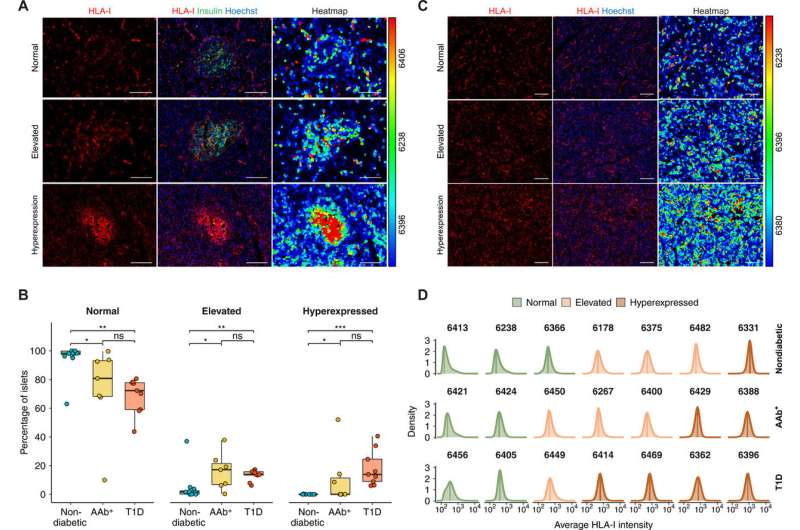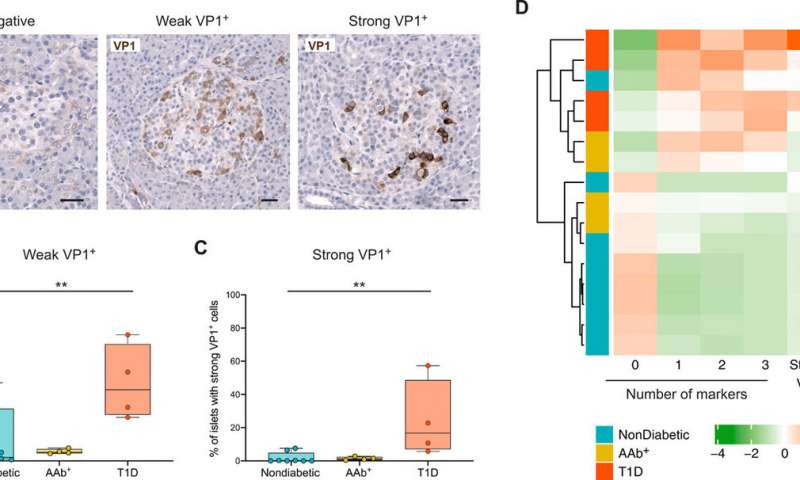Relationship between type 1 diabetes, interferon response and viral infection is first step toward preventive therapies

A study from an international team of researchers from the Helmholtz Diabetes Center at Helmholtz Zentrum Munich, the Institute of Biomedical and Clinical Science at University of Exeter Medical School, and the Department of Medicine at the University of Tennessee has uncovered the role of interferon responses to viral infections and in insulin production and inflammation in people with type 1 diabetes. Understanding this mechanism is the first step toward developing preventive therapies or medical interventions for those at risk of type 1 diabetes. The findings have been published in Science Advances.
Type 1 diabetes (T1D) is often referred to as “juvenile diabetes.” It is an autoimmune disorder in which the body’s immune response attacks the insulin-producing cells of the pancreas, the result of which is a lifelong dependence on insulin replacement therapies. Certain gene markers are indicated in a predisposition to T1D, but whether the disease is a response to an environmental cause or genetic remains unclear. Insulin injections and finger-stick or continuous blood glucose monitoring devices are used in conjunction to supply the body with adequate insulin. However, this treatment is often complicated and insufficient to maintain normal blood glucose levels, requires strict dietary regulation to work reliably, and there is no cure or preventive therapy.
Interferons are a protein released in response to viral attack and play a central role in the body’s immune response. While interferons have long been associated with T1D, the nature of this relationship is not fully understood.
Dr. Teresa Rodriguez-Calvo, corresponding author of the study and Junior Group Leader of the Type 1 Diabetes Pathology Research Unit at the Institute of Diabetes Research, Helmholtz Zentrum München, discussed the research with Medical Xpress: “The objective of our study was to investigate interferon responses in the pancreas of people with type 1 diabetes. To do this, we studied samples from the pancreas obtained through the Network from Pancreatic Organ Donors with Diabetes (nPOD),” an organization that provides human pancreatic and related tissues for medical research.
With nPOD’s cadaveric pancreas samples, the team were able to test organs from people with T1D and without—a total of 280 samples—for the presence or absence of an interferon response, and simultaneously, the relationship of an interferon response to the presence or absence of viral infection.
Dr. Rodriguez-Calvo explained the findings: “We observed that several interferon sensors are expressed in the islets of Langerhans,” small areas of hormone-producing tissues scattered through the pancreas; a human adult has about a million islets of Langerhans. “An interesting observation was that in diabetic individuals, these interferon sensors were predominantly observed in islets where insulin producing cells were still present. However, the detection of these interferon response molecules was associated with a low expression of genes important for insulin secretion, which indicates an alteration in insulin production.”

“These interferon sensors were also more abundant in islets that contained a high number of immune cells, suggesting that they induce inflammation,” says Dr. Rodriguez Calvo. “We also observed an association of these molecules with a protein from the capsid of enteroviruses, which indicates that they are induced in response to viral infections, as we would expect for interferon responses.”
In short, explains Dr. Rodriguez Calvo, “We found in the pancreas of people with type 1 diabetes that several molecules produced in response to interferons have a negative impact in insulin production and they induce inflammation, attracting immune cells with capacity to kill insulin producing beta cells. Our data also suggest that the detection of these molecules in the pancreas is associated to viral infections.”
Every finding related to T1D is important; more than 1.6 million Americans and 400,000 people in the UK are diagnosed with the disease, and those numbers are climbing—especially in Black, Latino and American Indian/Alaska Native populations.
At current, there are no preventive measures to guard against T1D. That’s what Dr. Rodriguez Calvo and her team hope to change. “Our study shows the potential importance of interventions that prevent or eliminate viral infections in people at risk of developing type 1 diabetes and also in those that already have the disease. It also supports the use of therapeutic strategies that could diminish interferon-induced inflammation in individuals with type 1 diabetes.”
“Our current goal is to further characterize these immune responses and to investigate how they could be controlled. We also want to study how the immune system recognizes viral proteins as well as self-proteins during the course of type 1 diabetes,” she explains, “to be able to stop the immune attack to beta cells.” That intervention, theoretically, could prevent developing T1D in those who are at risk. Developing such a therapy will require much more work in the lab, but identifying this mechanism of self-destructive immune response and its relationship to T1D and viral infection is a giant leap forward in developing preventive or curative drugs.
Source: Read Full Article
